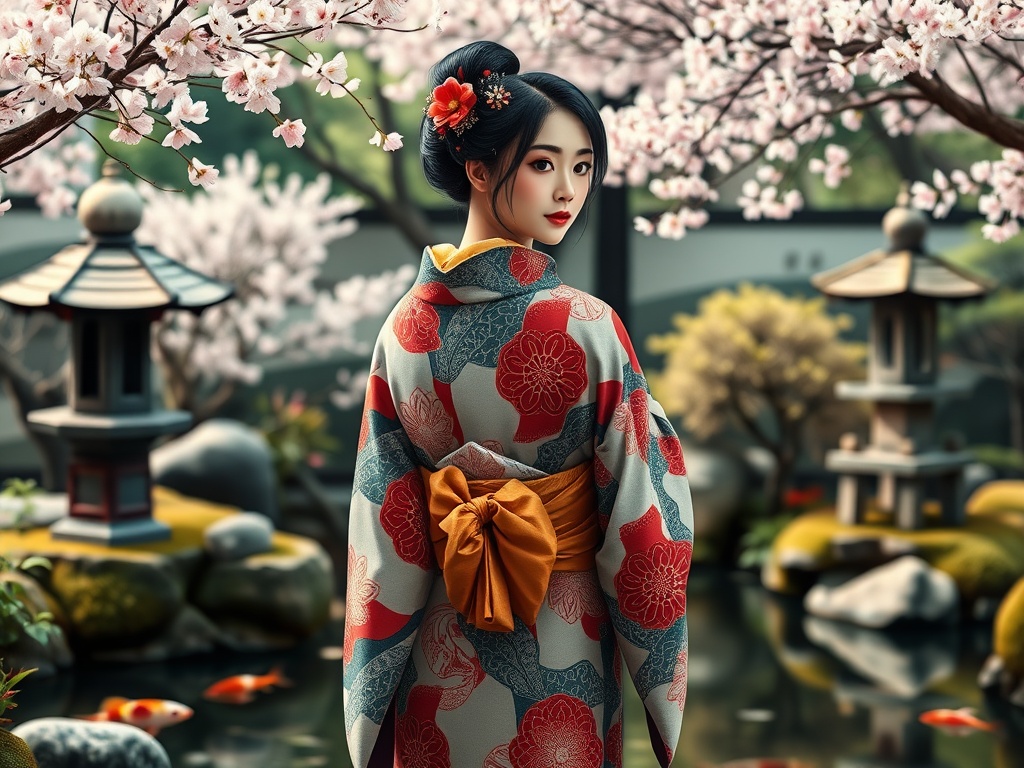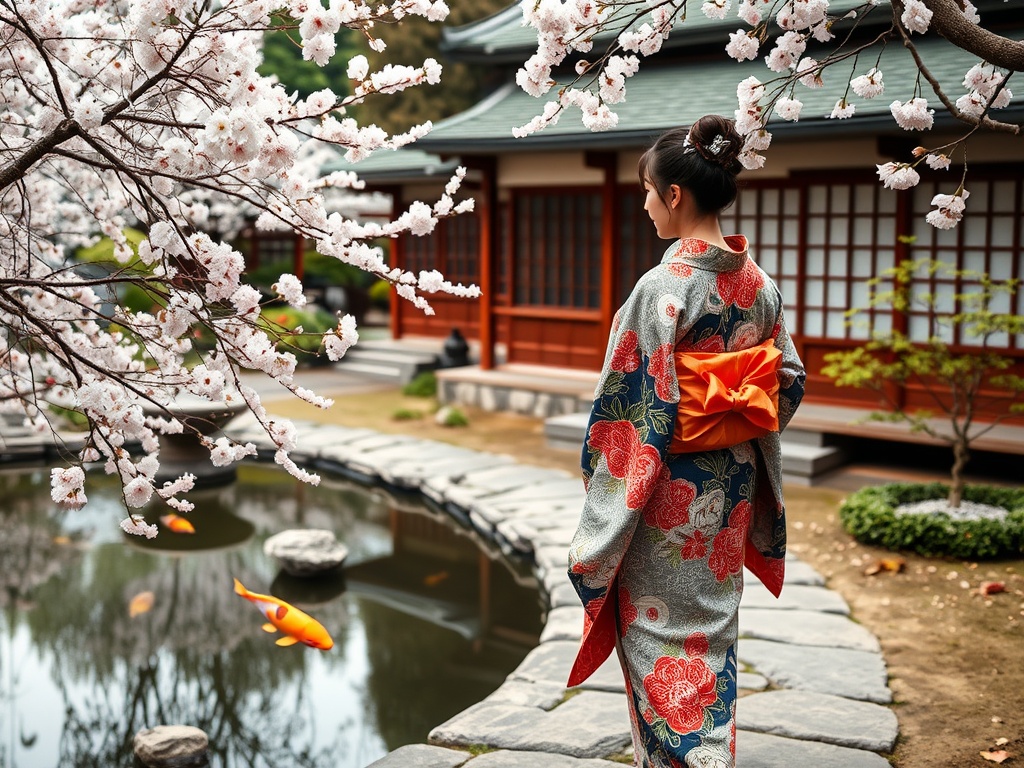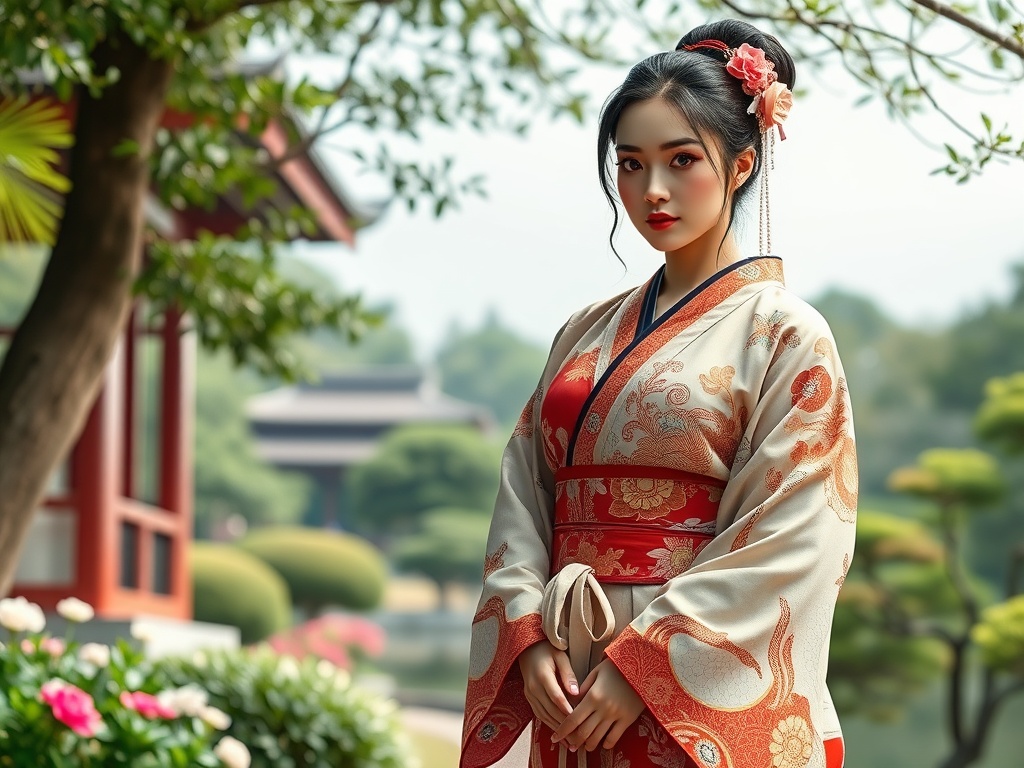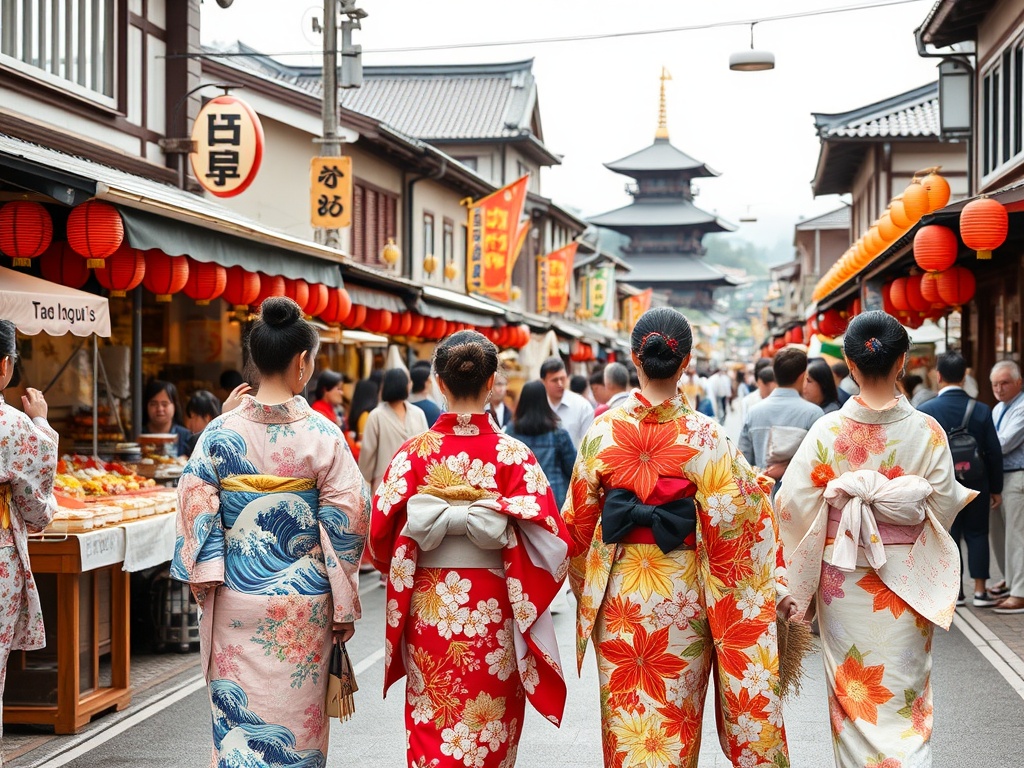The Enchanting World of Kimono: A Journey Through Time
Win a Free Trip to Japan!
Experience cherry blossoms and ancient temples
Step into the vibrant tapestry of Japan’s cultural heritage with a captivating exploration of the kimono. This iconic garment is more than just clothing; it is a symbol of Japanese tradition, artistry, and history. For those with a passion for travel and a love for cultural experiences, understanding the kimono is akin to unlocking a piece of Japan’s soul.
The kimono is a masterpiece of craftsmanship, reflecting the exquisite skills of artisans who dedicate their lives to this traditional art. Each kimono is a canvas, telling stories through its meticulous designs, colors, and patterns. The process of making a kimono involves several intricate steps, from weaving the fabric to hand-painting delicate motifs. This careful attention to detail results in a garment that is not only beautiful but also deeply meaningful.
Historically, kimonos were worn by all classes in Japan, but the designs and materials varied widely based on the wearer’s status and the occasion. Today, they are often reserved for special events, such as weddings, tea ceremonies, and festivals, making them an integral part of Japan’s living tradition.
Understanding the various types of kimonos and their appropriate occasions is essential for any visitor seeking a deeper appreciation of Japanese culture.
- Furisode: Typically worn by young, unmarried women, these colorful kimonos are distinguished by their long, flowing sleeves. They are often donned during Coming of Age Day and other formal events.
- Tomesode: Characterized by shorter sleeves, tomesode are worn by married women. These kimonos are often seen at weddings and formal gatherings.
- Yukata: A casual summer kimono made from lightweight cotton, perfect for festivals and hot weather. It is popular among both men and women.
- Houmongi: Versatile and elegant, these kimonos can be worn by both married and unmarried women for semi-formal occasions like tea ceremonies and parties.
Each type of kimono carries its own charm and etiquette, offering a unique glimpse into the wearer’s personality and the cultural significance of the event.
Obi Artistry: The Intricate Belt That Tells a Story
Delve into the fascinating world of Japanese women’s traditional fashion and discover the extraordinary artistry behind the obi, a quintessential component of the kimono ensemble. The obi, far more than a mere accessory, serves as a stunning focal point that embodies centuries of cultural heritage and symbolism. As you explore the vibrant streets of Japan, notice how this intricate belt enhances the elegance of a kimono, weaving stories into its very fabric, much like a storyteller capturing the essence of a tale.
The creation of an obi is an art form in itself, demanding exceptional skill and dedication. Craftsmanship is paramount, with each obi meticulously woven and embroidered to create striking patterns and motifs that often hold special significance. Traditionally, the design and color of an obi are carefully selected to complement the kimono and the occasion. From the more subdued hues worn at formal gatherings to the vibrant, eye-catching designs that grace festivals, the obi remains a powerful expression of artistry and personal style.
One of the most intriguing aspects of the obi is its ability to convey meaning through its intricate designs. Historical events, nature, and even poetic expressions find a place in the motifs that adorn an obi. For instance, a chrysanthemum pattern might symbolize longevity and rejuvenation, while a crane motif might represent good fortune and happiness. By choosing an obi with specific designs, the wearer can subtly communicate sentiments and aspirations, adding an extra layer of depth to their attire.
In the delicate dance of kimono coordination, the obi plays a pivotal role. It is the centerpiece that can elevate a kimono from simple to spectacular. The way it is tied is also significant, as different knots and styles can indicate the wearer’s age, marital status, and the formality of the event. The art of tying an obi, known as obimusubi, is a skill passed down through generations, with numerous styles such as the taiko (drum), fukuro (bag), and otaiko (drum knot) each telling their own stories.
For travel and tourism enthusiasts, experiencing obi artistry firsthand is an unforgettable journey into Japan’s rich cultural tapestry. Many regions across Japan offer workshops where visitors can learn the art of obi tying and even create their own designs. This immersive experience allows travelers to not only appreciate the obi’s beauty but also understand the profound cultural significance it holds. Whether attending a traditional festival or a serene tea ceremony, the obi serves as a reminder of Japan’s dedication to preserving beauty and tradition through every thread.
Seasonal Sensations: Decoding the Colors and Patterns in Yukata
As the seasons shift, so too does the vibrant tapestry of the yukata, a garment that captures the essence of Japanese summer. This traditional attire, known for its lightweight fabric and casual elegance, transforms with the changing months, offering a dazzling array of colors and patterns that mirror nature’s own palette. For travel and tourism enthusiasts, understanding the seasonal symbolism in yukata designs provides a unique window into Japan’s cultural storytelling.
As cherry blossoms bloom in spring, yukata designs often reflect this fleeting beauty with delicate sakura motifs. These patterns not only celebrate the season but also evoke themes of renewal and the transient nature of life. As the summer heat intensifies, vibrant colors such as deep indigos, fiery reds, and oceanic blues dominate the yukata landscape, accompanied by motifs of cool water, fireworks, and lush greenery. Each design is carefully chosen to offer a sense of freshness and vitality, perfect for the festive atmosphere of summer matsuri (festivals).
Yukata patterns are more than decorative; they are imbued with cultural significance. Here is a list of some common yukata patterns and their symbolic meanings:
- Goldfish: Symbolizes prosperity and good fortune, often seen in summer festivals.
- Bamboo: Represents strength and resilience, a motif that transcends seasons.
- Morning Glories: Signify love and affection, capturing the essence of summer romance.
- Dragonflies: Emblematic of courage and happiness, a popular choice in children’s yukata.
To immerse yourself in the seasonal sensations of yukata, consider participating in a local festival or visiting a traditional onsen town where yukata are often worn. Many regions host workshops where visitors can learn about the artistry of yukata making and even try their hand at dyeing or patterning their own garments. Whether strolling through a bustling festival or enjoying a quiet evening by the sea, wearing a yukata allows you to blend into the rhythm of Japanese life, embodying the spirit of the season.
Hairstyles and Hair Ornaments: The Crown Jewels of Traditional Attire
Venture into the world of Japanese women’s traditional fashion, where elegance is woven not only into the fabric of kimonos and yukatas but also into the intricate hairstyles and hair ornaments that grace the heads of women. These adornments, often seen as the crowning jewels of traditional attire, offer a fascinating glimpse into Japan’s cultural heritage and artistry. For travel and tourism enthusiasts, exploring this facet of Japanese culture provides a rich, immersive experience that reflects both beauty and history.
Traditional Japanese hairstyles are masterpieces of craftsmanship, each style meticulously designed to complement the elegance of the kimono. From the shimada to the yoko-hyogo, these hairstyles are imbued with cultural significance and reflect the wearer’s status, age, and marital state. Often featuring elaborate arrangements of loops and buns, these hairstyles require considerable skill and patience, making them a true art form.
Complementing these exquisite hairstyles are hair ornaments known as kanzashi, which are not merely decorative but also steeped in symbolism. These ornaments range from simple, understated pins to elaborate, colorful arrangements that can transform a hairstyle from simple to spectacular.
- Types of Kanzashi and Their Significance:
- Hana Kanzashi: Flower-shaped ornaments often worn by geisha and brides, symbolizing beauty and elegance.
- Tama Kanzashi: Simple hairpins with spherical ends, representing purity and simplicity.
- Bira Bira Kanzashi: Featuring dangling strips that create a shimmering effect, symbolizing joy and festivity.
For those eager to experience Japan’s traditional fashion firsthand, visiting a kimono rental shop often includes the option to have your hair styled in a traditional manner, complete with kanzashi. Many cultural festivals and events, such as the Gion Matsuri in Kyoto, provide opportunities to see these hairstyles and ornaments in all their glory, offering a window into a world where fashion is art, and every detail tells a story.
Footwear Fascination: Get to Know Geta and Zori
As you explore the vibrant world of Japanese women’s traditional fashion, understanding the role of footwear is essential for a complete appreciation of the ensemble. The geta and zori are not just functional items; they are integral components that enhance the aesthetic harmony of the attire, each rooted in Japan’s rich cultural narrative. For the discerning traveler, these traditional footwear styles offer a unique lens through which to view Japan’s history and artistry, providing an opportunity to walk in the footsteps of tradition.
Geta, characterized by their wooden soles and elevated design, serve both practical and symbolic purposes. Traditionally worn with yukata or casual kimonos, geta are designed to keep the hem of the garment clean and away from the ground, especially during the rainy seasons. Their distinctive clacking sound on pavements has become synonymous with the rhythm of traditional Japanese streets.
- Design and Structure: Geta typically feature a wooden base with two ‘teeth’ known as ha, which elevate the wearer. The straps, often made from fabric, are positioned to ensure comfort while walking.
- Symbolic Sound: The sound of geta, known as karan-koron, is often associated with nostalgia and the elegance of traditional festivals.
Zori, more formal than geta, are typically worn with formal kimonos. Their design is inspired by the simplicity and grace of Japanese aesthetics, offering a quieter and more refined alternative.
- Material and Use: Zori are often made with rice straw or other woven materials, with modern versions featuring vinyl or silk. They are worn for formal occasions, including weddings and tea ceremonies.
- Comfort and Style: Unlike geta, zori have a flat base, making them more comfortable for long wear while still maintaining the elegance expected in formal settings.
For travel enthusiasts keen on experiencing traditional Japanese culture, trying on geta or zori is a must. Many kimono rental shops provide these footwear options, allowing visitors to complete their traditional attire. Additionally, exploring festivals or historical districts while wearing these traditional shoes can offer a deeper connection to the cultural landscape of Japan.
Textiles and Techniques: Discovering the Craft of Traditional Fabric Weaving
Embark on a journey through the rich tapestry of Japanese women’s traditional fashion, where the fabric itself is a storyteller, weaving tales of history, nature, and artistry. The textiles that form the foundation of kimonos and other traditional garments are celebrated for their beauty and craftsmanship, each thread spun with purpose and precision. For travel and tourism enthusiasts, delving into the world of traditional fabric weaving offers a captivating glimpse into the heart of Japan’s cultural heritage.
The creation of traditional Japanese textiles is a meticulous process, involving time-honored techniques that have been preserved and perfected over centuries. Each style of weaving is distinct, often tied to specific regions and their cultural narratives. The mastery involved in these techniques reflects the dedication of artisans who strive to maintain the integrity and beauty of these ancient crafts.
- Nishijin Weaving: Originating from Kyoto, this intricate technique is renowned for its luxurious brocades, often featuring gold and silver threads. Nishijin fabrics are synonymous with opulence and are frequently used for formal kimonos and obi.
- Kasuri Weaving: Known for its unique patterns created by dyeing sections of the thread before weaving, this technique produces textiles with a distinctive, blurred effect, adding depth and character to the garment.
- Shibori Dyeing: A resist-dyeing technique that creates stunning patterns, shibori is a testament to the imagination and skill of Japanese artisans. Each piece is a work of art, showcasing intricate designs achieved through folding, twisting, and binding the fabric before dyeing.
For those eager to witness the artistry of traditional fabric weaving firsthand, Japan offers an array of regions where these crafts are celebrated and preserved. Visiting these areas provides an opportunity to not only observe the techniques but also engage with the artisans who continue to breathe life into this cherished tradition.
Kyoto: As the birthplace of Nishijin weaving, Kyoto remains a hub of textile innovation and tradition. Visitors can explore workshops and museums dedicated to this craft, gaining insight into the meticulous process involved in creating these exquisite fabrics.
Shikoku: Known for its indigo dyeing and kasuri weaving, Shikoku offers a vibrant tapestry of traditional textiles. Travelers can participate in workshops where they can try their hand at creating their own kasuri designs, guided by skilled artisans.
Whether wandering through the historic streets of Kyoto or immersing oneself in the dyeing workshops of Shikoku, exploring Japan’s textile traditions offers a deeper understanding of the cultural narratives woven into every thread.



